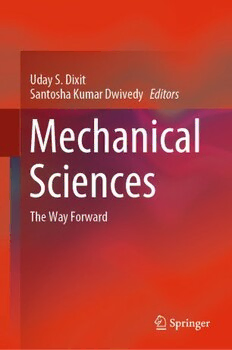
Mechanical Sciences: The Way Forward PDF
Preview Mechanical Sciences: The Way Forward
Uday S. Dixit Santosha Kumar Dwivedy Editors Mechanical Sciences The Way Forward Mechanical Sciences Uday S. Dixit Santosha Kumar Dwivedy (cid:129) Editors Mechanical Sciences The Way Forward 123 Editors Uday S.Dixit SantoshaKumar Dwivedy Department ofMechanical Engineering Department ofMechanical Engineering Indian Institute of Technology Guwahati Indian Institute of Technology Guwahati Guwahati, India Guwahati, India ISBN978-981-15-5711-8 ISBN978-981-15-5712-5 (eBook) https://doi.org/10.1007/978-981-15-5712-5 ©SpringerNatureSingaporePteLtd.2021 Thisworkissubjecttocopyright.AllrightsarereservedbythePublisher,whetherthewholeorpart of the material is concerned, specifically the rights of translation, reprinting, reuse of illustrations, recitation, broadcasting, reproduction on microfilms or in any other physical way, and transmission orinformationstorageandretrieval,electronicadaptation,computersoftware,orbysimilarordissimilar methodologynowknownorhereafterdeveloped. The use of general descriptive names, registered names, trademarks, service marks, etc. in this publicationdoesnotimply,evenintheabsenceofaspecificstatement,thatsuchnamesareexemptfrom therelevantprotectivelawsandregulationsandthereforefreeforgeneraluse. The publisher, the authors and the editors are safe to assume that the advice and information in this book are believed to be true and accurate at the date of publication. Neither the publisher nor the authors or the editors give a warranty, expressed or implied, with respect to the material contained hereinorforanyerrorsoromissionsthatmayhavebeenmade.Thepublisherremainsneutralwithregard tojurisdictionalclaimsinpublishedmapsandinstitutionalaffiliations. ThisSpringerimprintispublishedbytheregisteredcompanySpringerNatureSingaporePteLtd. The registered company address is: 152 Beach Road, #21-01/04 Gateway East, Singapore 189721, Singapore A Compendium to Commemorate the Silver Jubilee of the Mechanical Engineering Department Indian Institute of Technology Guwahati Editorial Advisory Board Amitabha Ghosh, Formerly Indian Institute of Technology Kanpur A. K. Mallik, Formerly Indian Institute of Technology Kanpur Gautam Biswas, Indian Institute of Technology Kanpur A. K. Dass, Indian Institute of Technology Guwahati U. K. Saha, Indian Institute of Technology Guwahati R. Ganesh Narayanan, Indian Institute of Technology Guwahati M. S. Shunmugam, Indian Institute of Technology Madras G. K. Ananthasuresh, Indian Institute of Science P. K. Das, Indian Institute of Technology Khargapur Sanjay Mittal, Indian Institute of Technology Kanpur S. S. Pande, Indian Institute of Technology Bombay Amit Agrawal, Indian Institute of Technology Bombay P. M. Pandey, Indian Institute of Technology Delhi J. Paulo Davim, University of Aveiro Vadim V. Silberschmidt, Loughborough University v About Indian Institute of Technology Guwahati Indian Institute of Technology (IIT) Guwahati was established in September 1994 as the sixth IIT of the country. The academic programs of IIT Guwahati started in 1995 with three departments—(1) Computer Science and Engineering, (2) Electronics and Communication Engineering, and(3) Mechanical Engineering; Department of Electronics and Communication Engineering was later renamed as ElectronicsandElectricalEngineering.Atpresent,theInstitutehas11departments and 5 inter-disciplinary academic centers covering engineering, science, and humanities disciplines, offering B. Tech., B.Des., M.A., M.Des., M.Tech., M.Sc., andPh.D.programs.Withinaquarter-century,IITGuwahatihasbeenabletobuild up world class infrastructure for carrying out advanced research and has been equipped with state-of-the-art scientific and engineering instruments. Starting with 64 students in 1995, student strength has crossed 6100 (more than 2700 under- graduatestudents).Therearemorethan400facultymemberstonurturethestudents and carry out high-quality research. Indian Institute of Technology Guwahati’s campusisona285hectaresplotoflandonthenorthbankoftheriverBrahmaputra, whichisaround19kmfromtheGuwahatiRailwayStationand23kmfromairport. WiththemajesticBrahmaputraononeside,andwithhillsandvastopenspaceson others, the campus provides an ideal setting for learning. vii viii AboutIndianInstituteofTechnologyGuwahati About Department of Mechanical Engineering, IIT Guwahati The Department of Mechanical Engineering is one of the largest and oldest departmentsofIndianInstituteofTechnologyGuwahati.Itstartedin1995withan intake of 16 students. Presently, it has about 400 undergraduate and 450 post- graduate students. There are about 45 faculty members in the department. Department offers a B.Tech. program in Mechanical Engineering and an M.Tech. Program in Mechanical Engineering with specialization in the following five streams: (1) Aerodynamics and Propulsion, (2) Manufacturing Science and Engineering,(3)ComputationalMechanics,(4)MachineDesign,and(5)Fluidsand Thermal. It has about 250 Ph.D. students working in the cutting edge areas of mechanical engineering. Department of Mechanical Engineering has a state-of-the-art workshop and severallaboratories.Amechatronicslaboratorywaswellestablishedin2000itself. Presently,anumberofprojectsarebeingexecutedinthearea ofmechatronics and robotics.Inthemanufacturingarea,researchactivitiesaregoingonwelding,metal forming, and advanced manufacturing such as laser-based manufacturing and additive manufacturing. Thereisa stronggroup ofComputationalFluid Dynamics (CFD)inthedepartment;experimentalactivitiesarealsobeingpursuedtovalidate CFD models. Research is being carried out in microfluidics also. There are some faculty members actively working in the area of energy; they are also associated withtheEnergyCenteroftheinstitute.Otheractiveresearchareasarefiniteelement method, nonlinear vibration, composites, and material science. ix x AboutDepartmentofMechanicalEngineering,IITGuwahati Preface MechanicalEngineeringmaybeconsideredasoldasthehumancivilization.Early humansusedvarioustypesoftoolsmadeofstoneandwood.Inventionofwheelis considered a landmark event in human civilization; it was extensively used in the fourth millennium BC. Although Archimedes (287 BC-212 BC), inventor of sev- eral machines, can be considered as the first Mechanical Engineer, mechanical engineeringdevelopedasadistinctpracticesincetheadventofJamesWatt’ssteam engine in the late eighteenth century. Institution of Mechanical Engineering was formed in the UK in 1847. MechanicalEngineeringisperhapsthemostdynamicdisciplinesofengineering. It collaborates with almost every engineering discipline and has given birth to several other disciplines. Traditional machines used to run with the help of water, steam,andcombustionoffossilfuels.Eventodaytheseareusedasenergysources. However, it is common nowadays to see active amalgamation of electrical and electronics engineering in engines and machines. Various cyber-physical systems areexploitingtheage-oldknowledgeofmechanicalengineeringalongwiththelatest knowledgedevelopedinthefieldofcomputerscienceandinformationtechnology. Inthepresentcentury,biologymayalsoplayamajorroleinmechanicalengineering. Department of Mechanical Engineering at Indian Institute of Technology (IIT)Guwahati,thesixthIITfoundedin1994,wasestablishedin1995.Itcatersto the teaching of traditional mechanical engineering as well as futuristic topics. To commemorate, its Silver Jubilee, it was decided to publish a compendium on mechanical engineering for providing an exposure to research directions in this ever-changing discipline. With the major support from Professor Amitabha Ghosh and other Editorial Advisory Board members, we could compile eleven articles written by the leading experts in mechanical engineering. Articles cover important gamut of mechanical engineering—solid mechanics, fluid mechanics, and manufacturing. The first article by Amitabha Ghosh throws light on the birth of mechanical engineering and speculates its future. The article argues that early steam-powered prime movers developed in seventeenth–eighteenth century triggered the birth of mechanical engineering. In the future, synthetic biology, molecular engineering, xi
